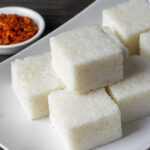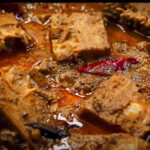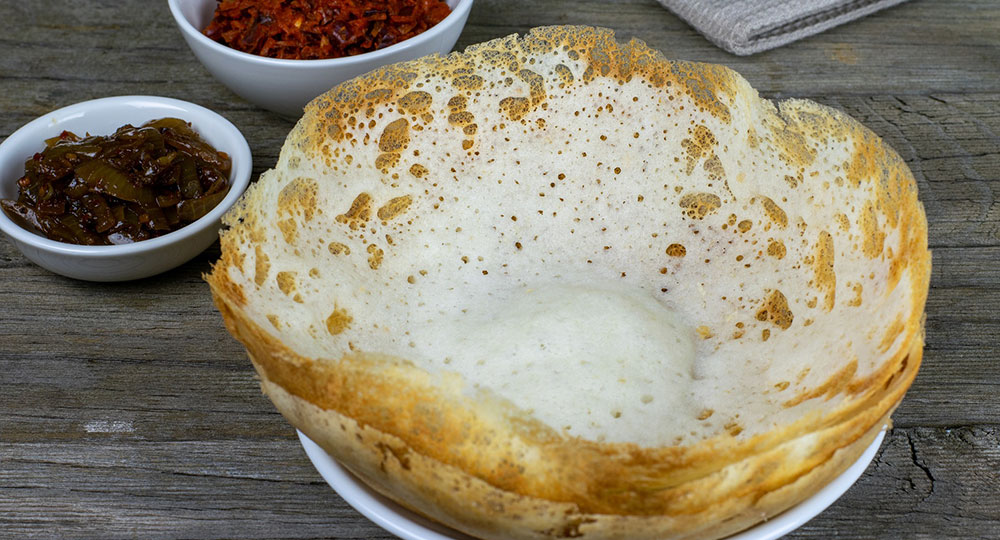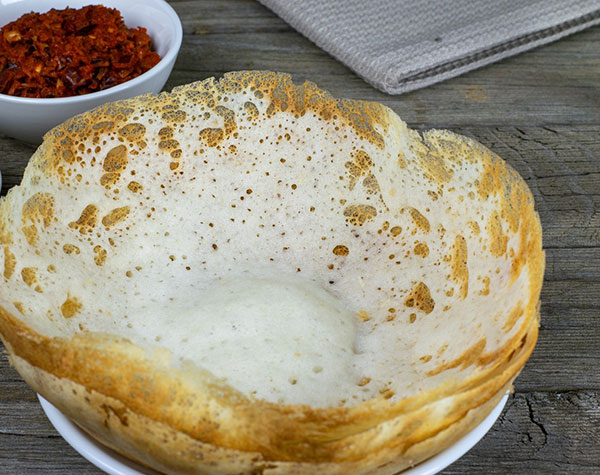
Vegetarian KIRIBATH (Milk Rice)for breakfast
August 1, 2024
Polos maluwa/ambula recipe
August 3, 2024
Vegetarian KIRIBATH (Milk Rice)for breakfast
August 1, 2024
Polos maluwa/ambula recipe
August 3, 2024
Plain Hoppers/ Appa
Plain hoppers, known locally as appa, are a cherished staple in Sri Lankan cuisine. These delicate, crispy-edged rice flour pancakes have become an emblem of the island's culinary heritage. Their simplicity and flavor, along with the traditional methods used to prepare them, encapsulate the essence of Sri Lankan food culture. This essay explores the history, preparation, and cultural significance of plain hoppers, highlighting their role in Sri Lankan daily life and their appeal to both locals and visitors.
60 mins
Easy
Serves 4
Origins Of Vegetarian Plain Hoppers
The origins of plain hoppers trace back to ancient times, when early inhabitants of Sri Lanka began experimenting with fermented rice flour. The practice of using fermented batters to create various dishes is not unique to Sri Lanka but is shared with other South and Southeast Asian cultures. Similar techniques are seen in dosa and idiyappam in India, suggesting a broader regional tradition of batter-based foods.
Sri Lankan hoppers, however, have evolved their own distinct identity. The preparation method, involving the fermentation of rice flour mixed with a small amount of yeast, is central to their unique texture and flavor. This fermentation process not only adds a slight tanginess to the batter but also helps in creating the light, airy consistency of the hoppers.
Preparation and Variations
The preparation of plain hoppers is both an art and a science. The batter is made from a combination of rice flour, all-purpose flour, coconut milk, and a bit of yeast. After mixing, the batter is left to ferment for several hours or overnight. This fermentation is crucial for developing the characteristic spongy center of the hoppers, while the edges become crisp and golden brown during cooking.
The cooking process involves pouring the batter into a specialized hopper pan or a small non-stick skillet. The pan is then tilted to spread the batter in a circular motion, creating a thin layer that crisps up around the edges while steaming to a soft center. The use of a lid during cooking helps to steam the batter, contributing to the soft and pillowy texture in the middle.
Several variations of hoppers exist, including egg hoppers (with a fried egg added during cooking), milk hoppers (sweetened with coconut milk), and string hoppers (steamed rice flour noodles). Each variation reflects different tastes and culinary traditions, but plain hoppers remain the most straightforward and quintessential version.
Cultural Significance
Plain hoppers hold a special place in Sri Lankan cuisine and culture. They are often enjoyed as part of breakfast or dinner and are considered a comforting and satisfying meal. The dish's simplicity reflects the agricultural roots of Sri Lankan society, utilizing staple ingredients like rice and coconut that are readily available on the island.
The preparation and consumption of hoppers are also embedded in social practices. In many households, making hoppers is a communal activity, often involving family members gathering around the kitchen to prepare and enjoy the meal together. This communal aspect highlights the role of food in fostering relationships and cultural continuity.
Modern Appeal
In contemporary Sri Lanka, plain hoppers are enjoyed not only at home but also in restaurants and eateries across the island. They are often served with an array of accompaniments, such as spicy sambol, dhal curry, or coconut chutney, enhancing their versatility and appeal. For tourists, hoppers provide a delightful introduction to Sri Lankan flavors and traditions, offering a taste of the island's rich culinary heritage.
Conclusion
Plain hoppers are more than just a simple dish; they are a symbol of Sri Lankan culinary tradition and cultural identity. Their history, preparation, and cultural significance reflect the broader context of Sri Lankan food culture, highlighting the importance of local ingredients and traditional techniques. As both a beloved staple and a culinary ambassador, plain hoppers continue to captivate and satisfy, bridging past and present in the vibrant tapestry of Sri Lankan cuisine.
Nutritions Of Hoppers
Plain hoppers, while delicious, are relatively simple in their nutritional profile. Here's a general overview of the nutritional aspects of plain hoppers, based on typical ingredients and preparation methods:
Basic Nutritional Breakdown
- Calories:
- Plain hoppers are moderate in calories, with one hopper containing approximately 100-150 calories, depending on its size and the amount of batter used.
- Macronutrients:
- Carbohydrates: Hoppers are primarily composed of carbohydrates, coming mainly from rice flour. They provide a quick source of energy. A typical hopper contains around 20-25 grams of carbohydrates.
- Proteins: They are relatively low in protein, with one hopper containing about 2-3 grams. Adding toppings like eggs or side dishes can increase the protein content.
- Fats: Plain hoppers are low in fat, with around 2-3 grams of fat per hopper, mostly coming from any oil used in cooking or the coconut milk in the batter.
- Fiber:
- The fiber content is relatively low, with around 1-2 grams per hopper. This can vary slightly depending on the type of flour used and any additional ingredients.
- Vitamins and Minerals:
- B Vitamins: Rice flour provides some B vitamins, such as thiamine and niacin, which are essential for energy metabolism.
- Iron: The iron content is modest, as rice flour has some iron, but it’s not a significant source.
- Calcium: If coconut milk is used, it can contribute some calcium, but not in large amounts.
Health Considerations
- Low in Nutrients:
- While hoppers are tasty, they are not particularly nutrient-dense. They are low in vitamins and minerals compared to whole grains and vegetables.
- Glycemic Index:
- Due to their high carbohydrate content, hoppers have a relatively high glycemic index. This means they can cause a rapid increase in blood sugar levels, which might be a consideration for individuals managing blood sugar levels or diabetes.
- Fat Content:
- The fat content is relatively low, but adding high-fat accompaniments or cooking with more oil can increase the overall fat content of the meal.
Enhancing Nutritional Value
To improve the nutritional profile of hoppers, consider these tips:
- Add Protein:
- Serve hoppers with protein-rich side dishes like eggs, lentil curry, or yogurt.
- Incorporate Vegetables:
- Include vegetables in the meal, such as a vegetable curry or a fresh salad, to boost fiber and vitamin content.
- Use Whole Grains:
- While traditional hoppers use refined rice flour, you can experiment with whole grain flours or blends to increase the fiber and nutrient content.
In summary, plain hoppers are a tasty and traditional dish, but they are low in protein and certain nutrients. They are best enjoyed as part of a balanced diet that includes a variety of other nutrient-rich foods.
Vegetarian Plain Hoppers Recipe For Cook
Cooking plain hoppers is relatively simple once you get the hang of it. Here's a step-by-step guide to help you make these delicious rice flour hoppers:
Ingredients:
- 1 cup rice flour
- 1/2 cup all-purpose flour
- 1 cup water (adjust as needed)
- 1/2 cup coconut milk
- 1/2 teaspoon active dry yeast
- 1/2 teaspoon sugar
- 1/2 teaspoon salt
Instructions:
- Prepare the Yeast:
- Dissolve the yeast and sugar in about 2 tablespoons of warm water (not hot, about 100°F or 37°C). Let it sit for 5-10 minutes until it becomes frothy. This step activates the yeast.
- Make the Batter:
- In a large mixing bowl, combine the rice flour, all-purpose flour, and salt.
- Add the activated yeast mixture, water, and coconut milk to the dry ingredients. Mix well until you get a smooth batter. The batter should be slightly thick but pourable. You may need to adjust the water to get the right consistency.
- Ferment the Batter:
- Cover the bowl with a clean cloth or plastic wrap and let it sit in a warm place for 4-6 hours or overnight. The batter should become slightly bubbly and expand as it ferments. If you're short on time, a few hours of fermentation will still work, but longer fermentation improves the flavor and texture.
- Heat the Hopper Pan:
- Heat a special hopper pan or a small non-stick skillet over medium heat. If using a non-stick skillet, you might want to lightly grease it with oil.
- Cook the Hoppers:
- Once the pan is hot, pour a ladleful of batter into the center. Quickly tilt and swirl the pan to spread the batter in a circular motion, creating a thin layer that coats the sides of the pan.
- Cover the pan with a lid and let it cook for 2-3 minutes. The edges should become crispy, and the center should be soft and cooked through. The lid helps to steam the batter, creating a soft center while the edges crisp up.
- Serve:
- Gently remove the hopper from the pan using a spatula. Serve it warm with your favorite accompaniments like sambol, curry, or even just a drizzle of honey.
Tips:
- If the batter is too thick, add a little more water to achieve the right consistency.
- If you’re using a non-stick pan, make sure it’s well-heated before adding the batter to avoid sticking.
Enjoy your homemade plain hoppers!

